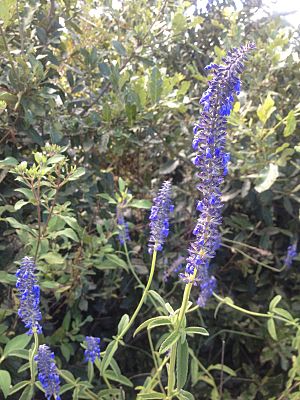Lavender leaf sage facts for kids
Quick facts for kids Lavender leaf sage |
|
|---|---|
 |
|
| Near Popocatépetl | |
| Scientific classification | |
| Genus: |
Salvia
|
| Species: |
lavanduloides
|
| Synonyms | |
|
|
Salvia lavanduloides, also known as the lavender leaf sage, is a type of flowering plant. It belongs to the Lamiaceae family, which is also called the mint family. This plant is originally from parts of North and Central America, including Mexico, Guatemala, Honduras, and Costa Rica.
You can often find the lavender leaf sage growing in mountain forests. It has a special ability: it is adapted to survive fires. This means it has developed ways to live and even thrive in areas where fires happen.
Contents
Discovering Lavender Leaf Sage
The name Salvia lavanduloides gives us a clue about this plant. Salvia is the scientific name for a large group of plants known as sages. Many sages are known for their strong smells and beautiful flowers. The word lavanduloides means "like lavender," suggesting its leaves might look or smell similar to lavender plants.
This plant was first described in 1818 by a scientist named Carl Sigismund Kunth. Scientists give plants these special two-part names so everyone around the world knows exactly which plant they are talking about.
Where Does it Grow?
The lavender leaf sage is native to a few countries in North and Central America. You can find it naturally in:
- Mexico
- Guatemala
- Honduras
- Costa Rica
It prefers to grow in "montane forests." Montane means "of or relating to mountains." So, these are forests found in mountainous regions. The climate in these areas can be cooler and sometimes wetter than lowlands.
How Does it Survive Fire?
One of the most interesting things about Salvia lavanduloides is that it is "fire-adapted." This means the plant has special features that help it survive or even benefit from wildfires. Many plants in areas where fires are common have developed these adaptations.
For example, some fire-adapted plants might:
- Have thick bark that protects them from heat.
- Store seeds that only open after a fire, releasing them into newly cleared, nutrient-rich soil.
- Regrow quickly from their roots after the top part of the plant burns away.
This adaptation helps the lavender leaf sage continue to grow and spread even in environments where fires are a natural part of the ecosystem.
What is the Lamiaceae Family?
Salvia lavanduloides is part of the Lamiaceae family, which is commonly known as the mint family. This is a very large and important plant family. Many plants we use every day for cooking or medicine belong to this group.
Some famous members of the mint family include:
- Mint
- Basil
- Oregano
- Thyme
- Rosemary
- Lavender
Plants in the mint family often have square stems, opposite leaves (meaning leaves grow directly across from each other on the stem), and flowers that are often shaped like tubes. They are also well-known for producing strong, pleasant smells from oils in their leaves.
Reproduction and Life Cycle
Like most flowering plants, Salvia lavanduloides reproduces using seeds. Its flowers are important for this process. Flowers attract pollinators, like bees or hummingbirds, which help carry pollen from one flower to another. This process is called pollination.
After successful pollination, the flowers develop into fruits that contain seeds. These seeds are then dispersed, either by wind, water, animals, or by the plant itself. When the seeds land in a suitable place, they can sprout and grow into new lavender leaf sage plants, starting the life cycle all over again.

